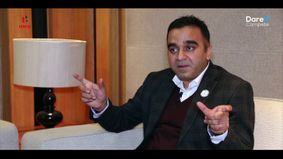Improve your Résumé by turning Bullet Points into Stories

You’re sitting with a cup of coffee, reading your daily newspaper, when a job alert on your phone catches your attention. You pick your phone, see the LinkedIn notification and quickly go through the skills they require and hit apply, without further delay or ado. A week goes by and then a month but you do not hear from the recruiter. You had a decent LinkedIn profile and their requirements aligned perfectly with your skill-sets; so, what went wrong?
Here is what we think you need to tweak - your résumé. Job applications are designed to judge candidates on various parameters. And a major part of your application consists of your résumé which speaks volumes about the person you are, both personally and professionally. Thus, where hiring managers test potential candidates on grounds of their past accomplishments and future goals, you need to voice your career story with your résumé.
Let's see how you can follow a few techniques to improve your résumé.
1. Begin with Résumé Headline and Summary
Your résumé headline should be crisp and must talk precisely about you. You can also choose to club a few phrases in this format - Start-up Builder | Brand Strategist | Marketing Head. For the summary, you must brief your career accomplishments as clearly as possible along with what you would bring to the new position.
Try bridging the challenges you’ve worked on with ones the hiring manager is facing currently, to show how you are the best fit for the position.

2. Résumé Story
With an interesting headline and a short summary that piques the reader’s interest, it is time to tell the tale - of your career. Start with an introduction to a milestone that you’ve achieved in the current organisation. Gradually, drift to the details of your current position in the company.
Talk about how you’ve helped the organisation grow in the past few years - how your contribution added significant value. Frame your achievements in the form of a story that speaks about your growth curve, the lessons you’ve learnt along the way and how you’ve matured and progressed with the organisation.
3. Details of the Résumé Story
Once you have mentioned your achievements briefly, it is now time to tell your story in greater detail. To improve your résumé, use traditional bullet points and add areas of your accomplishment - Branding and Marketing, Partnerships, Sales, Strategy Development, etc.
This strategy of talking about a major achievement in the introduction and then elaborating it further in bullet points with intricate details, adds credibility to your work and thus, your résumé. It makes your résumé story a lot more compelling and powerful.
4. Tweak your LinkedIn Profile
One thing that matters a lot, apart from your résumé, is your profile on LinkedIn. So, once you are done designing your résumé and adding the necessary information, it is time to recoup your LinkedIn Profile. Recruiters often hop into this elite Social Media platform which speaks about your calibre, your credentials and your achievements thus far.
So, before you lay down your guard and apply to the coveted job role, login to LinkedIn and make use of the 2000-character summary section. Highlight your progress and your accomplishments to tell your story to the recruiter and let them know how you stand apart from other candidates. Pro tip - Write your summary in the first-person to grab the reader’s attention. Also, leave it open for further communication by adding your contact details in the end.
5. Cover Letter and Interviews
When you articulate your résumé in the format of a story, you get well-versed with it too. By the end of this process of résumé and profile writing, you will be all set to start working on your cover letter.
Research well about the hiring companies and see what they’re looking for. Once you are well-equipped with both sides of the story, you will understand which stories will convince recruiters that you’re the best fit for the company.
Crafting your résumé and profile with stories instead of bullet points or fragmented lists will urge the recruiter to examine your profile closely to understand what makes you a different candidate. This examination will be both, overall and specific - considering the ways you improved your previous organisation.
Even though following this pattern does not guarantee a job, it will definitely land you more opportunities and thus, interviews. Use each of these to narrate your story, tailoring them to the requirements of each hiring company. Go ahead and take the leap. This one step to improve your résumé might end up changing your career trajectory forever. All the best!
Login to continue reading
And access exclusive content, personalized recommendations, and career-boosting opportunities.
















Comments
Add comment